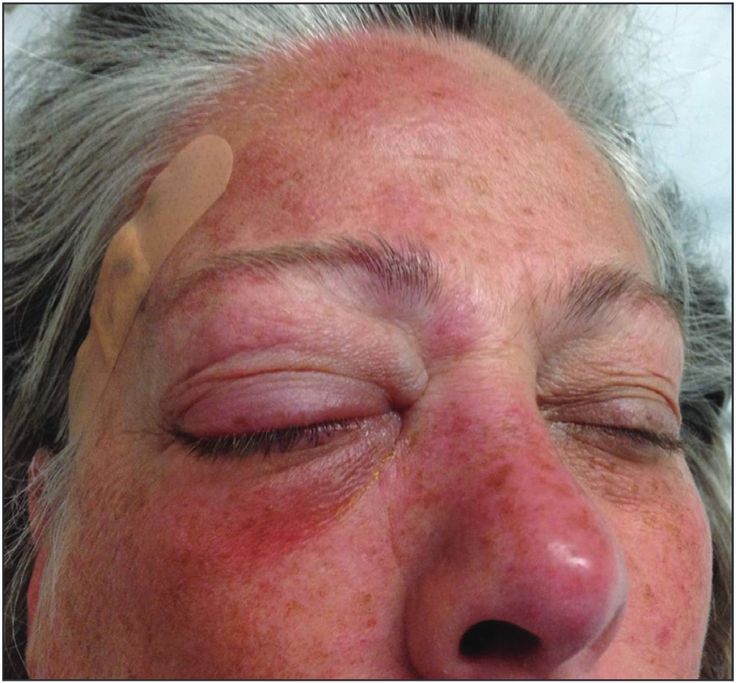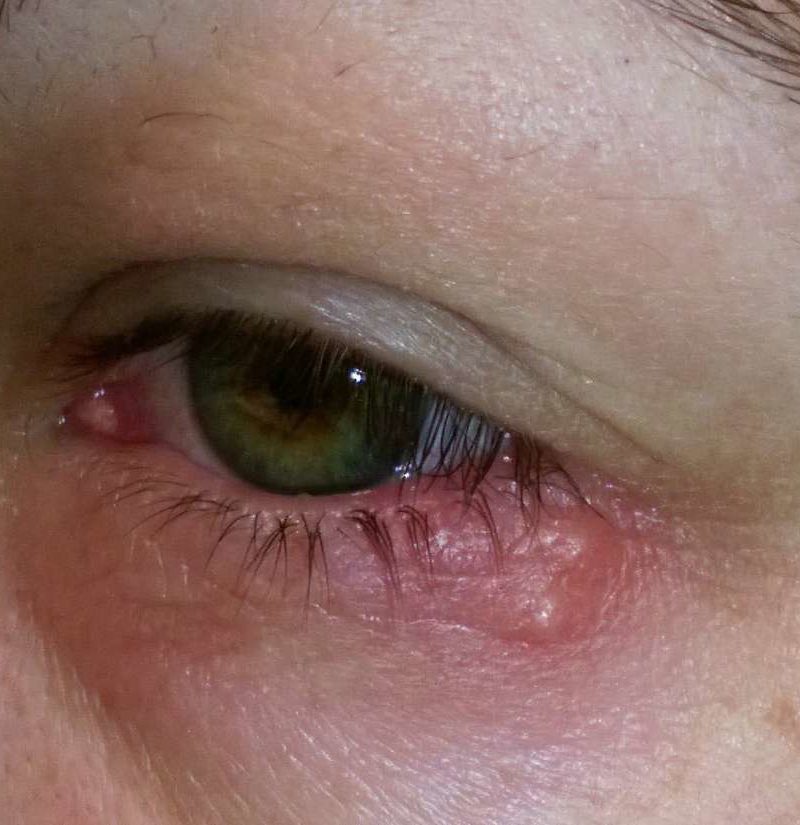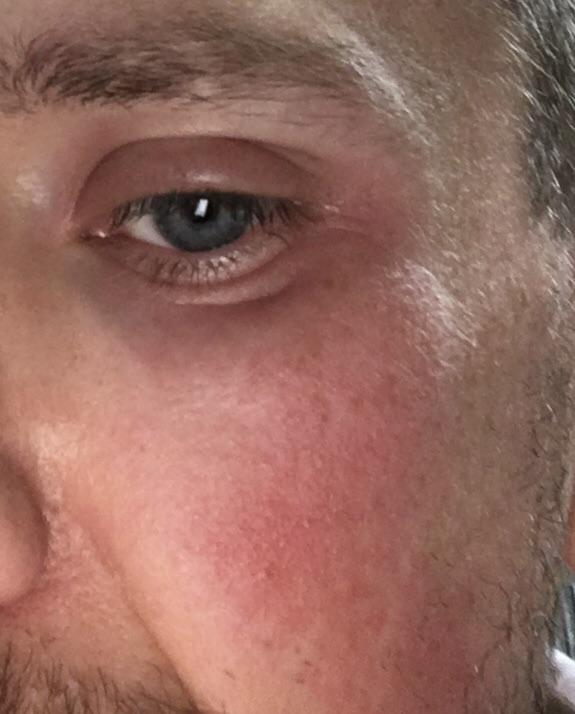You Cannot Get Shingles From Someone With Chickenpox
You cannot get shingles from someone with shingles or chickenpox.
But you can get chickenpox from someone with shingles if you have not had chickenpox before.
When people get chickenpox, the virus remains in the body. It can be reactivated later and cause shingles if someone’s immune system is lowered.
This can be because of stress, certain conditions, or treatments like chemotherapy.
Complications Of Shingles On The Face
Shingles can cause different complications, depending on where they are. When they spread to or around the eye, they can affect the cornea and nerve cells that respond to light. This can lead to complications that include redness, swelling, puffiness, vision problems and infections.
If the condition develops near or inside the ear, it can lead to imbalance issues, hearing problems, and weakened facial muscles. Around the mouth, shingles can make it difficult to eat and even alter your sense of taste.
Who’s At Risk For Shingles
Anyone who has ever had chickenpox can get shingles, but the risk increases with age. People older than age 60 are up to 10 times more likely to get shingles than younger people. Other factors that increase your risk include:
- Some cancer medicines
- A weak immune system from illnesses such as cancer or HIV
A quarter of adults will develop shingles at some point, and most are otherwise healthy.
Recommended Reading: How Often To Get Shingles Vaccine
What Does Shingles On The Face Look Like
Shingles usually starts as a painful, tingling, itching, or numb sensation in the affected area of skin.
A rash may later develop and eventually produce painful blisters. The rash may have a flushed color or appearance.
Blisters from shingles, which may ooze, typically contain fluid. Blisters that form can burst and become open sores or dry out and form scabs.
The rash may appear on just one site or in several places, and it may appear on only one side of the face.
However, the appearance of a shingles rash may vary from what is typical depending on the individual.
Hearing Loss And Facial Weakness

Complications of herpes zoster oticus and Ramsay Hunt syndrome might include hearing loss and facial weakness. For most people, these are temporary symptoms, but it is possible for the damage to become permanent, especially if shingles is left untreated.
Ramsay Hunt syndrome accounts for up to 12% of facial paralysis. In some cases, it has a worse outcome than Bells palsya condition that causes temporary weakness in the muscles of the face.
Don’t Miss: How To Avoid Shingles Virus
Can Eye Shingles Cause Blindness
Even with proper treatment, some eye shingles patients still develop eye disorders such as corneal scarring, glaucoma or retinal disease.
For example, eye shingles can cause:
-
A corneal dendrite which may lead to a scar
In the most severe cases of eye shingles, a patient may need a corneal transplant.
Eye shingles is not contagious. It cannot be spread to another person.
However, a person who has shingles-related rash anywhere on their body can transmit chickenpox virus to someone who hasn’t already had chickenpox or been vaccinated for the condition.
Eye Shingles Diagnosis And Treatment
Your doctor can diagnose shingles by observing the rash on your face or eyes. They might take a fluid sample from the blister to test for the varicella-zoster virus.
Doctors will also examine the following parts for the presence of swelling, inflammation, or damage:
- Other parts of your eye, including the eyelid, the optic nerve, etc.
Also Check: What Do Pictures Of Shingles Look Like
Shingles In Eyes Pictures
With shingles in eye, most people will have a blistering rash form on eyelids, forehead and in some cases on the tip and side of the nose. The rash can appear the same time as the blister or after the blisters have gone away.
Shingles will often be accompanied by other symptoms such as redness around eye, watery eyes, and in some cases blurry vision. Here are some pictures of how eye shingles will look like.
Triggers Of Shingles In The Eye
Below is a brief summary of the common triggers of shingles in the eye
Age
As you continue to grow older, your immune system continues to become weaker. If you have varicella zoster from shingles in the past, your chances of getting shingles increases as you advance in age.
Old people need to be very well taken care of so that there immune system stays strong enough for shingles not to erupt.
Viral diseases
Another trigger for shingles is viral diseases such as HIV/AIDS. When you have a viral disease, your immune system is totally weakened and you are likely to get shingles. The shingles in the eye in such a case will always come back following treatment.
Stress
Stress increases the chances of getting shingles although indirectly. When you are stressed, your appetite levels drop greatly. This will definitely result to a weakened immune system since you are likely to skip your meals.
Strong medication
There are some medications that are too strong for your immune system to totally handle them. Such medications make you vulnerable to attacks such as those by shingles.
For that reason, if you are taking very strong medications that are probably making it difficult for you to eat you should be monitored closely by your doctor.
You May Like: What Do Shingles Look Like On A Human Body
What Are Shingles In The Eye
The varicella-zoster virus causes shingles. In many people, the varicella-zoster virus remains dormant, while in others, it activates later. This virus can appear as shingles, a painful rash, several decades after you first encountered chickenpox.
In 10-20% of people who encounter shingles, the rash appears on or around the eye. When the shingles rash appears in the eye, it becomes herpes zoster ophthalmicus, named for its location. Most of the time, shingles do not appear in the eye, but you can have shingles on the eye and nearby facial areas as well as more common parts of your body, like your back or chest.
While most people recover fully after having shingles, eye shingles do present unique problems. The virus can cause problems like vision loss and scarring. It can also have longer-lasting effects on anyone who has a compromised immune system.
When Should I See My Doctor
See your doctor as soon as possible if you are experiencing any symptoms of shingles. Starting treatment with antiviral medicines within 3 days of the rash appearing should reduce the severity of symptoms and the risk of further complications, including post-herpetic neuralgia.
See your doctor straight away if you have symptoms of shingles and are experiencing the following:
- symptoms that affect your eye area
- a temperature of 38°C or higher
You should also see your doctor if you are pregnant, or have a weakened immune system due to medicine that suppresses the immune system, or a condition that weakens your immune system.
You May Like: First Signs Of Shingles On Stomach
Other Signs And Symptoms Of Shingles
While shingles commonly causes pain, headache, and itching, it can also present a range of other symptoms.
The severity of the symptoms will vary from person to person. Some people may have mild symptoms, whereas others may feel intense pain.
Other symptoms of shingles include:
- sensitivity to light
- fluid-filled blisters
Seek immediate medical care if you experience symptoms of shingles.
How Is It Treated

It is best to start treatment as soon as possible after you notice the rash. See your healthcare provider to discuss treatment with antiviral medicine, such as acyclovir. This medicine is most effective if you start taking it within the first 3 days of the rash. Antiviral medicine may speed your recovery and lessen the chance that the pain will last for a long time.
Your provider may also recommend or prescribe:
- medicine for pain
- antibacterial salves or lotions to help prevent bacterial infection of the blisters
- corticosteroids
Don’t Miss: Can You Get Shingles If You Had The Chickenpox Vaccine
Urgent Advice: Get Advice From 111 As Soon As You Suspect Shingles
You might need medicine to help speed up your recovery and avoid longer-lasting problems.
This works best if taken within 3 days of your symptoms starting.
111 will tell you what to do. They can arrange a phone call from a nurse or doctor if you need one.
Go to 111.nhs.uk or .
Get an urgent GP appointment
A GP may be able to treat you.
Ask your GP surgery for an urgent appointment.
How To Treat Shingles On The Face
Shingles on the face may require referral to a specialist for treatment, such as an ophthalmologist.
There are also medications that can ease symptoms. When taken early, they can help the blisters to clear more quickly and decrease pain. Treatment is most effective if you take it within 3 days of your symptoms starting.
Recommended Reading: Should I See A Doctor For Shingles
Risk Factors For Shingles
Once youve had chickenpox as a child, youre at risk of getting shingles later in life. The virus stays dormant, or asleep, in your body. It hides out in nerve cells near your spinal cord, but it can become active again when youre older.
Youre at increased risk of getting shingles if you:
- had chickenpox as a child
- are age 50 or older because your immune system weakens as you age
- have a weakened immune system because of a disease like cancer, HIV infection, or AIDS
- take medicine that weakens your immune system, such as chemotherapy or radiation for cancer, or stops your body from rejecting a transplanted organ
Shingles is especially serious in some groups of people, including:
What Are The Symptoms Of Shingles
The initial symptoms of shingles include:
- a burning, tingling or itching sensation
- a stabbing sensation
- numbness in the affected area of the body
- sensitivity to light
- fever and/or headache
Two to 3 days after these symptoms appear, a painful rash will appear on the sensitive area of skin, usually on one side of the body in the area of one skin nerve .
At first this rash consists of painful red bumps that quickly develop into fluid-filled blisters, which will eventually have a crusty surface. The rash can last for 10 to 15 days.
Also Check: What Age Can You Get Shingles Vaccine
What Are Eye Shingles
Eye shingles is a painful rash of the skin around the eye. It typically affects the forehead and skin of the upper lid. It also can affect the side or tip of the nose. If not quickly daignosed and treated, shingles in the eye can cause permanent damage to your vision.
Shingles on the face and eye is caused by the same virus that causes chickenpox. Shingles can be limited to the area around your eye or it can cause a painful red rash elsewhere on your body.
Over the past six decades, cases of shingles have been on the rise.
The number of cases of eye shingles in the United States tripled from 2004 to 2016, according to University of Michigan’s Kellogg Eye Center.
Researchers found that people over age 75 have the greatest risk. Whites and women also present with a higher incidence of eye shingles.
What explains this increase? Weakening of the immune system from chronic diseases and stress are factors.
Dr. Christopher Rapuano, MD, chief of Cornea Service at Wills Eye Hospital, one of the top U.S. ophthalmic specialty hospitals, says few Americans are getting vaccinated for shingles, which is the best way to avoid the disease and protect your eyes.
Shingles can cause bad things to happen to the eyes, and some of those things can happen even with good treatment, he says.
What You Should Know About Shingles
You may not remember having the itchy, painful welts caused by chickenpox. But according to the Centers for Disease Control and Prevention , 99.5 percent of people born before 1980 were infected at one point or another. Anyone who has been infected is at risk for shingles.
When chickenpox infections fade, the virus that caused them does not. Chickenpox is caused by the varicella-zoster virus , and it’s a member of the herpes family. Like most herpes-based illnesses, VZV never really goes away. Instead, it lies dormant within your body.
VZV rests within your nerves, and during a shingles outbreak, the virus triggers inflammation and pain along a nerve band. The CDC says one in three people will get shingles. Most have just one outbreak, but some have repeated problems.
Mayo Clinic says shingles can cause more than pain. The condition can also cause:
- Persistent fatigue.
- Sensitivity to light.
Typically, people with shingles will experience blisters along just one small area that wraps around the torso. But any part of the body served by nerves can get hit with shingles. Symptoms last for about two weeks before fading away.
Recommended Reading: What To Do When You Get Shingles Rash
When Shingles Strikes Your Face
Dozens of muscles line your face, and they help you talk, eat, blink, and wink. All those movements start with nerve impulses, and any nerve band can get hit with a shingles outbreak.
Just one side of the face is touched by the issue, and the blisters will not spread. If you touch the bumps on one side of your face and then touch the other, you can’t spread the problem around. The virus sits within the nerves, far below the skin, and you can’t influence how the infection spreads.
Your shingles may appear on or around your eyelid, and that can make blinking difficult or painful. Sometimes, the tissues swell, and that makes it hard for you to open your eye.
Preventing Shingles In The Eye

When it comes to shingles and especially ocular shingles prevention is the best medicine.
Fortunately, there are two shingles vaccines:
-
Shingrix A fairly new vaccine, Shingrix is recommended for adults ages 50 and over. You get Shingrix in two doses two to six months apart, and its more than 90% effective in protecting you from shingles and post-herpetic neuralgia. Protection stays strong for at least four years after you get vaccinated.
-
Zostavax An older vaccine for shingles, Zostavax is a live vaccine that is less effective but may be used in healthy adults ages 60 and up if theres a reason they cant have Shingrix administered. For example, someone who is allergic to a component of Shingrix may opt for Zostavax.
The availability of a newer, more effective vaccine should prevent even more shingles outbreaks. We recommend the vaccine for all of our patients, Dr. Rapuano says.
WORRIED YOU MIGHT HAVE EYE SHINGLES ?Find an optician near you and schedule an appointment.
Page published on Sunday, 24 May 2020
Page updated on Wednesday, 2 February 2022
Find an optician near you
Don’t Miss: Where To Buy Pabco Shingles
How Can You Prevent Spreading The Virus
You cant give shingles to someone else, but the varicella-zoster virus is very contagious. If you have shingles and you expose someone else who has not had chickenpox or the chickenpox vaccine, you can give them the virus. Theyll get chickenpox, not shingles, but this puts them at risk for shingles later on.
Youre contagious when your blisters are oozing, or after they break and before they crust over. Do the following to avoid spreading the virus to others:
- Keep your rash covered, especially when the blisters are active.
- Try not to touch, rub, or scratch your rash.
- Wash your hands thoroughly and often.
Avoid contact with people whove never had chickenpox or the chickenpox vaccine, especially:
How Is Herpes Zoster Diagnosed
Doctors diagnose shingles through a physical clinical exam. They may take a skin sample to test further if the causative factors remain unknown. However, if you have another type of herpes virus, the test will read positive.
Shingles on the face can lead to various eye compilations, including glaucoma and blindness. That makes it important to seek medical intervention from an ophthalmologist if you notice any of the aforementioned symptoms.
You May Like: How To Know If You Have Shingles
How Eye Shingles Are Treated
You do not have to endure shingles. With the help of your doctor, you can overcome the discomfort and help the outbreak to heal. You can also take some steps to reduce the frequency and severity of your outbreaks.
The key is to get help within three days of the start of an outbreak. That is the moment at which your immune system is still strong but could use a little boost. Antiviral medications can tamp down the virus and send it back to the nerve root, so you will feel a bit more comfortable.
You will still be at risk for future outbreaks, as shingles can’t be cured. But the treatment can keep the excruciating pain and damage at bay.
Your doctor may ask you to spend a few days in the hospital. You will get around-the-clock care for your outbreak, and your doctor can watch the infection carefully and step in if sight-stealing complications appear.
When you are released to your home, there are plenty of things you can do to ease your discomfort. The American Academy of Ophthalmology recommends:
- Cool compresses. A moist, damp towel placed over your closed eyes can relieve some of your pain.
- Painkillers. If your doctor agrees, you can use medications like aspirin to ease distress.
- Eye drops. Your doctor may suggest soothing drops to help your tissues knit back together.